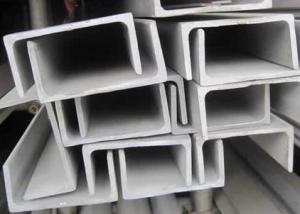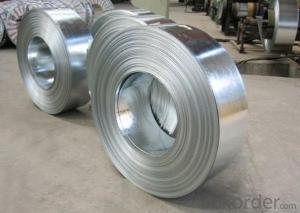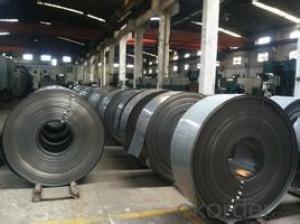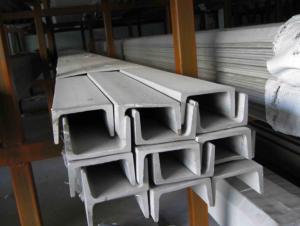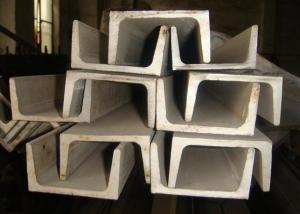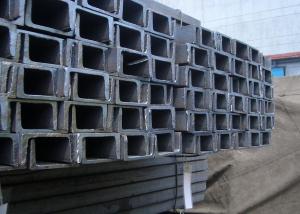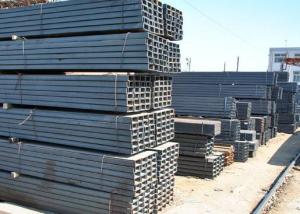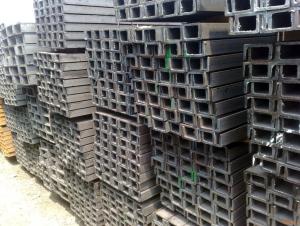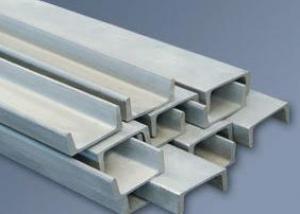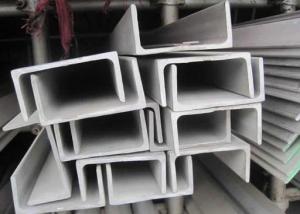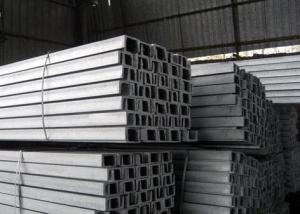201 Stainless Steel Channels
- Loading Port:
- China Main Port
- Payment Terms:
- TT or LC
- Min Order Qty:
- 5 Tons m.t.
- Supply Capability:
- 1000 Tons Per Month m.t./month
OKorder Service Pledge
OKorder Financial Service
You Might Also Like
Stainless Steel Channel
1.Size: 3mm to 24mm Thickness
2.Material:SUS201,202,301,304,304L,316,316L ,321 etc.
3.Length: 4m to 6m,or according to the customer's requirement
4.Standard: AISI,JIS,GB,DIN
5.Finish: Cold Drawn ,hot rolled & Polishing
6.Testing: Each heat number and batch must be tested for both chemical and mechanical properties
7.Application: Produce screw and nut, engine parts, indoor and outdoor decorating,etc.
|
Size (mm) |
Thickness (mm) | ||||||||
|
H×B |
3 |
4 |
5 |
6 |
7 |
8 |
9 |
10 |
12 |
|
Mass (Kg/m) | |||||||||
|
40×20 |
1.79 |
|
|
|
|
|
|
|
|
|
50×25 |
2.27 |
|
|
|
|
|
|
|
|
|
60×30 |
2.74 |
3.56 |
4.37 |
5.12 |
|
|
|
|
|
|
70×35 |
3.23 |
4.21 |
5.17 |
6.08 |
|
|
|
|
|
|
80×40 |
3.71 |
4.84 |
5.96 |
7.03 |
|
|
|
|
|
|
90×45 |
4.25 |
5.55 |
6.83 |
8.05 |
|
|
|
|
|
|
100×50 |
4.73 |
6.18 |
7.62 |
8.98 |
10.3 |
11.7 |
13 |
41.2 |
|
|
120×60 |
|
|
9.2 |
10.9 |
12.6 |
14.2 |
|
|
|
|
130×65 |
|
|
10.1 |
11.9 |
13.8 |
15.5 |
17.3 |
19.1 |
|
|
140×70 |
|
|
|
12.9 |
14.9 |
16.8 |
18.8 |
20.7 |
|
|
150×75 |
|
|
|
13.9 |
16 |
18.1 |
20.2 |
22.2 |
26.3 |
|
160×80 |
|
|
|
14.8 |
17.1 |
19.3 |
21.6 |
23.8 |
28.1 |
|
180×90 |
|
|
|
16.7 |
19.4 |
22 |
24.5 |
27 |
32 |
|
200×100 |
|
|
|
18.6 |
21.6 |
24.5 |
27.4 |
30.2 |
35.8 |
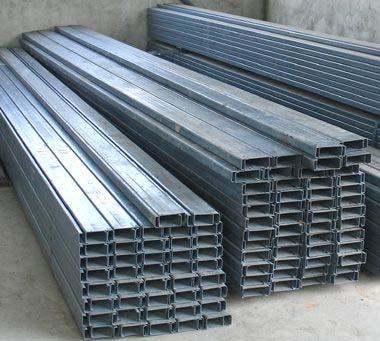
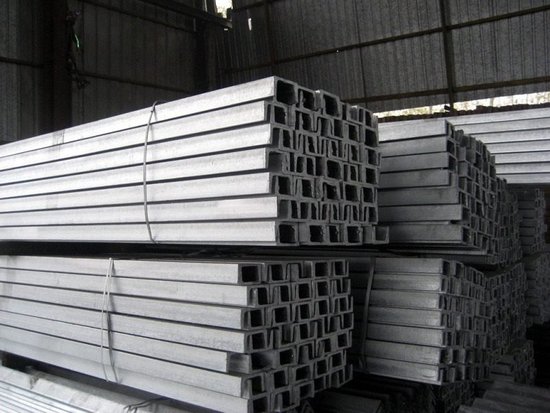
- Q:Are stainless steel channels resistant to rust and corrosion?
- Yes, stainless steel channels are highly resistant to rust and corrosion due to the presence of chromium in their composition.
- Q:Can stainless steel channels be used for conveyor systems or material handling equipment?
- Yes, stainless steel channels can be used for conveyor systems or material handling equipment. Stainless steel is a durable and corrosion-resistant material, making it suitable for applications that involve moving and handling various materials. It provides strength and stability for conveyor systems and can withstand heavy loads and harsh environments. Additionally, stainless steel's hygienic properties make it ideal for industries that require cleanliness and sanitation, such as food processing and pharmaceuticals.
- Q:Do stainless steel channels require any special coatings or treatments?
- Special coatings or treatments are not necessarily needed for stainless steel channels. The material itself, stainless steel, is renowned for its innate ability to resist corrosion. However, in certain situations where extra safeguarding is necessary, stainless steel channels can undergo coating or treatment processes to enhance their performance. These processes might involve passivation, which eliminates any free iron or surface impurities from the stainless steel, further strengthening its resistance to corrosion. Additionally, stainless steel channels can be coated with a variety of substances such as epoxy, polyurethane, or powder coatings to offer additional protection against chemical exposure, abrasion, or UV rays. The decision to implement special coatings or treatments depends on the specific application and the desired level of protection in a given environment.
- Q:How do stainless steel channels perform in high humidity environments?
- Stainless steel channels are known for their excellent performance in high humidity environments. Due to their corrosion-resistant properties, stainless steel channels can withstand prolonged exposure to moisture without rusting or degrading. This makes them highly suitable for use in areas with high humidity, such as coastal regions or industrial settings where moisture levels are consistently high. The chromium content in stainless steel channels forms a protective oxide layer on the surface, which acts as a barrier against moisture and prevents the metal from reacting with oxygen. This oxide layer is stable and ensures that the channels remain resistant to corrosion, even in humid conditions. Furthermore, stainless steel channels are also resistant to pitting and crevice corrosion, which are common issues in high humidity environments. These types of corrosion occur when moisture gets trapped in small gaps or crevices, leading to localized corrosion. However, stainless steel's resistance to these forms of corrosion ensures the channels maintain their structural integrity even in humid conditions. In addition to corrosion resistance, stainless steel channels also possess high strength and durability, making them a reliable choice for applications in high humidity environments. They can withstand exposure to moisture, humidity, and other environmental factors without losing their mechanical properties or structural stability. Overall, stainless steel channels are an excellent choice for use in high humidity environments. Their corrosion resistance, durability, and strength make them capable of performing well and maintaining their integrity even in the most challenging humid conditions.
- Q:Can stainless steel channels be used in the construction of swimming pools?
- Indeed, swimming pools can be constructed using stainless steel channels. Renowned for their robustness, longevity, and ability to resist corrosion, stainless steel channels are a splendid selection when it comes to pool construction. They serve to establish the structural framework and bolster the pool walls, guaranteeing both stability and durability. Moreover, stainless steel channels can endure the harsh chemicals and constant immersion in water without succumbing to rust or degradation. Consequently, they present a dependable and hassle-free alternative for building pools.
- Q:How do stainless steel channels compare to aluminum channels in terms of weight and strength?
- Stainless steel channels and aluminum channels differ in terms of weight and strength. Stainless steel channels are generally heavier compared to aluminum channels due to the higher density of stainless steel. This increased weight can be advantageous in applications that require stability and durability. In terms of strength, stainless steel channels have a higher tensile strength compared to aluminum channels. Stainless steel is known for its excellent strength and resistance to corrosion, making it suitable for applications that require a high level of durability and structural integrity. On the other hand, aluminum channels have a lower tensile strength but are known for their lightweight properties, making them ideal for applications where weight is a crucial factor. Ultimately, the choice between stainless steel channels and aluminum channels depends on the specific requirements of the application. If weight is a concern and the application does not require high strength, aluminum channels may be the preferable option. However, if strength and durability are paramount, stainless steel channels are the better choice.
- Q:Do stainless steel channels require any protective coatings?
- Stainless steel channels do not necessarily require protective coatings, as stainless steel itself is already highly resistant to corrosion and rust. The main advantage of stainless steel is its ability to form a passive protective layer on its surface, which prevents further oxidation and corrosion. However, there are certain circumstances or environments that may require the use of protective coatings on stainless steel channels. For example, if the channels are exposed to highly corrosive chemicals or harsh weather conditions, applying a protective coating can provide an extra layer of defense against corrosion. Additionally, in industries where hygiene is crucial, such as food processing or pharmaceuticals, a protective coating may be applied to ensure the channels are easily cleanable and resistant to bacterial growth. Ultimately, the need for protective coatings on stainless steel channels depends on the specific application and the level of corrosion resistance required.
- Q:Are stainless steel channels suitable for use in the aerospace industry?
- Yes, stainless steel channels are suitable for use in the aerospace industry. Stainless steel offers several desirable properties such as high strength, corrosion resistance, and durability, making it an ideal material for aerospace applications. These channels can be used for structural support, framework, or other critical components in aircraft and spacecraft where reliability and performance are crucial.
- Q:What are some common industry standards or specifications for stainless steel channels?
- There are several common industry standards and specifications for stainless steel channels that ensure their quality and suitability for various applications. These standards help manufacturers and consumers maintain consistency, reliability, and safety. Some of the most widely recognized standards and specifications for stainless steel channels include: 1. ASTM A276: This standard specifies the requirements for stainless steel bars and shapes, including channels, for general structural purposes. It covers various grades of stainless steel and sets guidelines for chemical composition, mechanical properties, and tolerances. 2. ASTM A484: This specification outlines the general requirements for stainless steel bars, billets, and forgings, including channels. It provides guidelines for dimensions, tolerances, surface finishes, and heat treatment conditions. 3. ASTM A582: This standard covers the requirements for free-machining stainless steel bars, including channels. It specifies chemical composition limits, mechanical properties, and recommended heat treatment processes. 4. EN 10088: This European standard provides the technical delivery conditions for stainless steel products, including channels. It covers various grades of stainless steel and specifies requirements for chemical composition, mechanical properties, and surface finishes. 5. AISI Manual: The American Iron and Steel Institute (AISI) manual provides comprehensive information on the design, fabrication, and installation of stainless steel structures. It includes guidelines for selecting stainless steel grades, including channels, based on specific applications and environmental conditions. 6. ISO Standards: The International Organization for Standardization (ISO) has developed several standards related to stainless steel, including channels. ISO 2768, for example, provides general tolerances for linear and angular dimensions, while ISO 9001 outlines quality management system requirements for manufacturers. These industry standards and specifications are essential for ensuring the quality, performance, and compatibility of stainless steel channels across different industries such as construction, manufacturing, and transportation. Adhering to these standards helps maintain consistency, facilitates international trade, and ensures customer satisfaction by providing reliable and safe products.
- Q:Are stainless steel channels suitable for flooring or grating systems?
- Stainless steel channels can indeed be suitable for flooring or grating systems, depending on the specific requirements and conditions of the application. Stainless steel is highly durable, corrosion-resistant, and has excellent strength-to-weight ratio, making it a popular choice for various industrial and commercial applications. In flooring systems, stainless steel channels can be utilized to provide structural support and create a stable walking surface. They can be used in areas that require high load-bearing capacity, such as factories, warehouses, or outdoor platforms. Stainless steel channels can withstand heavy foot traffic and can effectively distribute weight, ensuring the safety and longevity of the flooring system. Similarly, in grating systems, stainless steel channels can be used to support and secure grating panels. Stainless steel's resistance to corrosion and ability to withstand harsh environments make it suitable for applications that require frequent exposure to water, chemicals, or extreme temperatures. Stainless steel channels can be used in industrial settings, such as wastewater treatment plants, oil refineries, or chemical processing facilities, where a durable and long-lasting grating system is required. However, it is important to consider the specific requirements and conditions of the application before determining the suitability of stainless steel channels for flooring or grating systems. Factors such as load capacity, environmental conditions, and maintenance requirements should be taken into account to ensure the optimal performance and longevity of the system. Consulting with a professional engineer or supplier specializing in stainless steel channels can provide valuable guidance and ensure the right choice for the specific application.
1. Manufacturer Overview |
|
|---|---|
| Location | Jiangsu, China |
| Year Established | 2010 |
| Annual Output Value | above US$8 million |
| Main Markets | East Asia, Middle East, West Europe |
| Company Certifications | |
2. Manufacturer Certificates |
|
|---|---|
| a) Certification Name | |
| Range | |
| Reference | |
| Validity Period | |
3. Manufacturer Capability |
|
|---|---|
| a)Trade Capacity | |
| Nearest Port | Shanghai |
| Export Percentage | |
| No.of Employees in Trade Department | above 50 people |
| Language Spoken: | English, Chinese, Arabic |
| b)Factory Information | |
| Factory Size: | about 15000 square meter |
| No. of Production Lines | above 4 |
| Contract Manufacturing | OEM Service Offered,Design Service Offered |
| Product Price Range | Average |
Send your message to us
201 Stainless Steel Channels
- Loading Port:
- China Main Port
- Payment Terms:
- TT or LC
- Min Order Qty:
- 5 Tons m.t.
- Supply Capability:
- 1000 Tons Per Month m.t./month
OKorder Service Pledge
OKorder Financial Service
Similar products
New products
Hot products
Related keywords

